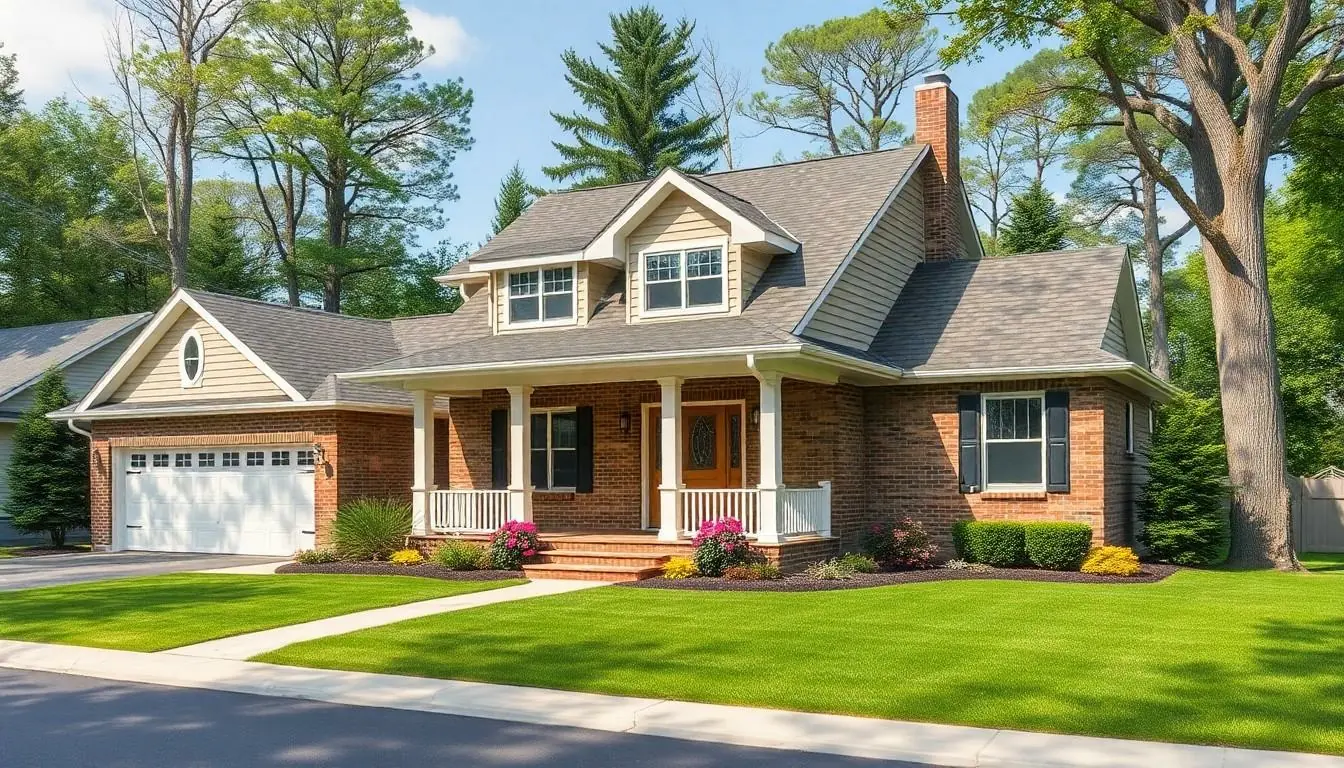In the charming state of Connecticut, where picturesque towns meet the hustle and bustle of city life, homeowners face a unique challenge: protecting their slice of paradise. With unpredictable weather and the occasional squirrel trying to invade your attic, having the right homeowners insurance isn’t just smart—it’s essential. After all, you wouldn’t want to find yourself in a pickle when Mother Nature decides to throw a tantrum, would you?
Connecticut homeowners insurance offers peace of mind, ensuring that your cozy abode is safeguarded against the unexpected. From protecting your prized possessions to covering those pesky repair costs, understanding your options can save you from a headache and a hefty bill. So, let’s dive into the world of homeowners insurance, where coverage meets comfort, and you can keep those worries at bay while enjoying your beautiful New England home.
Table of Contents
ToggleOverview of Connecticut Homeowners Insurance
Connecticut homeowners insurance provides essential coverage for individuals protecting their properties and possessions. Policies typically cover damage caused by incidents like fire, theft, or vandalism. Residents face unique risks due to unpredictable weather patterns, including snowstorms and heavy rainfall.
Each policy includes dwelling coverage, safeguarding the home structure from various hazards. Personal property coverage protects belongings inside the home, such as furniture and electronics. Liability coverage is crucial as it protects homeowners from legal claims if someone gets injured on their property.
Several factors influence the cost of homeowners insurance in Connecticut. Location plays a significant role, as areas prone to flooding or severe weather may have higher premiums. The age of the home also affects pricing, with older structures often needing more coverage due to potential risks. Homeowners can expect better rates if they maintain a good credit score.
Choosing the right policy ensures adequate protection against unexpected events. Many homeowners consider adjusting their deductibles, which can lower their premiums. Bundling policies can also provide discounts, helping homeowners save on overall insurance costs.
It’s wise to review policies annually to ensure coverage aligns with current needs. Changes in home value, renovation projects, and new purchases affect insurance requirements. Staying informed on local risks and state regulations enhances homeowners’ ability to make knowledgeable decisions about their insurance options.
Types of Coverage Offered

Homeowners insurance in Connecticut offers various coverage types tailored to residents’ needs. Understanding these options helps homeowners choose the best policy for their situation.
Dwelling Coverage
Dwelling coverage protects the home’s structure from perils like fire, storms, and vandalism. It covers repairs or rebuilding costs for the dwelling itself, including attached structures like garages and porches. Many policies provide coverage based on the home’s replacement value rather than the market value, ensuring adequate protection. Homeowners should assess recent renovations or upgrades, as these changes may affect their coverage limits.
Personal Property Coverage
Personal property coverage safeguards belongings such as furniture, electronics, and clothing against theft or damage. This coverage typically includes incidents like fire, theft, and water damage from burst pipes. Homeowners can choose between actual cash value or replacement cost coverage; the latter ensures that replacements are made at current market prices. Understanding what items count as personal property helps policyholders select appropriate coverage levels.
Liability Protection
Liability protection offers financial security against third-party claims resulting from injuries or accidents occurring on the property. This coverage can include legal fees, medical expenses, and settlements for damages awarded in lawsuits. Homeowners find it helpful, especially for incidents involving guests or invitees, as well as damages caused by pets. Assessing potential risks on the property ensures adequate liability coverage limits are in place.
Factors Affecting Premiums
Multiple elements influence homeowners insurance premiums in Connecticut. Understanding these factors can help homeowners make informed decisions about their policies.
Location and Environment
Local climate plays a significant role in determining premiums. Homes in areas prone to flooding or hurricanes typically face higher rates. Proximity to emergency services affects costs as well; properties near fire stations or police departments often receive discounts. Natural disasters like storms and heavy snow can lead to increased premiums, reflecting the risk to the property. Moreover, neighborhoods with higher crime rates lead to increased insurance costs due to the higher likelihood of theft or vandalism.
Home Characteristics
The age and condition of a home impact insurance premiums. Newer homes generally incur lower rates since they include updated safety features. Construction materials also factor into costs; brick or stone homes often attract lower premiums than wooden structures, which are more susceptible to fire. Additionally, the square footage of the home affects the coverage amount required. Homes with more square footage typically incur higher premiums due to the increased cost of rebuilding.
Personal Claim History
A homeowner’s previous claims history significantly influences premiums. Frequent claims may lead to higher rates as insurers view them as indicators of risk. Conversely, a strong history of few or no claims can result in lower premiums. Insurance companies often reward responsible homeowners with discounts for maintaining a clean claim record over time. Furthermore, claims for high-cost items like severe water damage can lead to more significant premium increases than smaller incidents.
Choosing the Right Policy
Selecting the appropriate homeowners insurance policy is vital for Connecticut residents. Key considerations help homeowners safeguard their properties effectively.
Comparing Different Insurers
Homeowners must evaluate various insurers to find the ideal coverage. Rates vary significantly between companies, requiring careful comparison. Look for insurers that offer the best combination of price and coverage benefits. Reading customer reviews and assessing claims processing efficiency can reveal an insurer’s reliability. Requesting quotes from multiple providers helps clarify differences in premiums and policies. Utilize online comparison tools to streamline this process and ensure comprehensive evaluations.
Understanding Policy Options
Understanding policy options is crucial for informed decisions. Most Connecticut homeowners insurance policies fall into standard categories, such as HO-1 to HO-6. Deciding between actual cash value coverage and replacement cost coverage impacts the amount reimbursed during a claim. Deductibles influence out-of-pocket expenses when filing claims; lower deductibles lead to higher premiums. Additionally, homeowners can consider adding riders for specific coverage needs, like jewelry or home businesses. Knowing these details allows homeowners to tailor their policy to reflect their unique circumstances and risks.
Recent Trends in Connecticut Homeowners Insurance
Homeowners in Connecticut are facing rising insurance premiums due to increasing weather-related risks. Insurers are adjusting rates to account for factors such as more severe storms and flooding potential. Recent data indicates average premiums rose by 5% from 2022 to 2023 across the state, reflecting these growing concerns.
In addition, more homeowners are opting for personalized coverage options. This trend emerges from a greater awareness of specific risks. Examples include adding endorsements for natural disasters or higher liability limits, catering to individual needs.
Homeowners are also embracing technology to manage their insurance policies. Many are utilizing apps and online services to track claims and communicate with agents. This shift towards digital tools enhances customer experience and improves policy management efficiency.
Furthermore, insurers are emphasizing the importance of bundling policies. Many homeowners are discovering savings through combined home and auto insurance packages. This strategy not only reduces costs but also simplifies the overall management of multiple insurance needs.
Another notable trend involves increased focus on environmental sustainability. Homeowners are investing in green upgrades, resulting in lower premiums through certain insurers. For instance, energy-efficient appliances and sustainable building materials can qualify for discounts.
Overall, awareness of local climate challenges drives homeowners to reassess and strengthen their insurance coverage. Understanding the evolving landscape of homeowners insurance helps residents protect themselves against unforeseen events, ensuring peace of mind.
Connecticut homeowners insurance is more than just a policy; it’s a crucial safeguard against the unexpected. With the state’s unique challenges like unpredictable weather and wildlife threats, having the right coverage can provide invaluable peace of mind.
By understanding the various components of homeowners insurance and evaluating personal needs, homeowners can make informed choices that protect their properties and belongings. As premiums continue to rise, being proactive in selecting and managing insurance policies becomes essential.
Staying informed about local risks and exploring options for tailored coverage can help homeowners navigate the complexities of insurance while ensuring their homes remain secure and protected.







